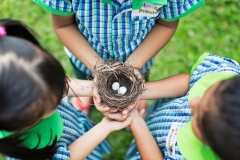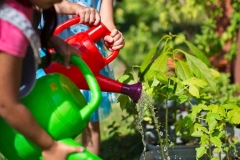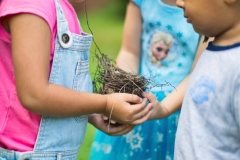1.What makes Pariposa unique?
At PARIPOSA, we believe children learn by doing and being self-directed. We provide hands-on and multisensorial experiences in a positive learning environment. We make room for mistakes and open communication. Children are given sufficient time to learn from their failures. Our excellent staff ratio is a vital factor in our program. We are also a pioneer childcare centre offering Lego education as part of our core curriculum.
Learning by doing allows children to become personally invested in their own learning process. This method is praised as a top teaching method by higher educational institutions, especially those in the fields of science, art and technology.
2. Are there any drawbacks to Pariposa?
Our approach is a “hands-on” approach. This may not meet the expectations of parents with traditional views on learning. ie. Hands-on vs worksheets.
3. What will a parent lose if they don’t sign up with Pariposa?
Firstly, parents will lose a placement at Pariposa as we have limited slots due to our excellent teacher-child ratio. Pariposa caters to each individual child as each child learns in a particular style. An exposure to their preferred method of learning increases their understanding of new information.
Secondly, we offer enrichment program (Lego-education, Pictogram &Gooeygram Art programs) as part of our core curriculum. These programs are conducted by our partners and trained professionals in-house at no additional costs to parents.
4.What are the top 3 fears parent’s face when selecting a centre? How do we address those fears?
FEAR #1- Will my child be in safe hands
FEAR #2- Will my child learn anything or just play whole day
FEAR #3- Will my child be able to cope with Primary school once he/she leaves K2.
These are normal anxieties every parent will face as they send their child away from them, be it a child-care, enrichment center, school or even living with a nanny/helper.
To address these issues, at Pariposa, we offer trial sessions for the parents to be comfortable and know us better before signing up. Our excellent child-teacher ratio meets every individuals child’s needs so that dedicated attention and focus is given to each child. Our curriculum is not purely play base but one that involves educational activities to make learning fun. We share our activities weekly with parents so that they are kept informed of their child’s activities.
5. What sort of results do parents see as a result of sending their child to Pariposa?
Children at Pariposa are more confident in expressing themselves with an attitude for the love of learning and love of school. Becoming actively engaged in their education builds confidence, as the lessons require the children to rely on their own abilities to obtain knowledge. That confidence and self-reliance inspires children to embrace the learning process and enthusiastically seek out additional knowledge.Reading readiness, writing, and math skills are incorporated into all activities to prepare them for the next leap.
6. Would you be able to share more about the Lego curriculum ? Like its benefits and how it started?
LEGO® Education provides a unique ‘hands-on, minds-on’ environment that supports and enriches the entire learning process. This program is designed for children from the Playgroup to Kindergarten levels. The ultimate purpose is to inspire and develop children to think creatively, reason systematically and release their potential to shape their own future – experiencing the endless human possibility.
Pariposa and Lego education shares the similar philosophy. Pariposa uses Lego as an extension and a tool to cultivate curiosity and imagination. Our goal is to make the students able to stand up to a problem and solve it. Pariposa aims to create lifelong learners for a drive of learning through its unique curriculum focused on hands-on learning.
Benefits of Lego Curriculum:
Social skills and the ability to work effectively with others are important to a child’s success. Using a hands-on approach, LEGO Education Preschool solutions enable children to work together to construct and discover their world. They’ll build from their imagination and use the scenarios to learn basic problem-solving and communication skills.
I. Early Math and Science: Introduce problem-solving skills using LEGO®Education
LEGO® Education Preschool solutions naturally inspire young minds to explore numbers, shapes and colors, and problem solving through playing together. Children learn to experiment by endlessly constructing and deconstructing their different creations. As they construct together, the colorful bricks and figures provide an engaging, hands-on way to understand concepts such as simple addition and subtraction.
II. Creative Exploration: Build their confidence as they bring their ideas to life (using Lego soft Blocks)
Children express themselves creatively and artistically while constructing the wonderful ideas from their imaginations. LEGO® bricks automatically engage multiple children, inviting them to construct together; discussing ideas and negotiating roles. They use the bricks as a tool for thinking, communicating and developing an understanding and appreciation of each other’s ideas and contributions.
III. Early Literacy and Language: Stimulate language development through playful learning experiences (using Story tales) Children learn about communication as they begin to express their thoughts and ideas. LEGO®Education Preschool encourages this development and introduces basic storytelling by asking children to construct fantastic fairy tales and sensational imaginative short stories with LEGO® DUPLO® bricks, characters and inspirational backdrop cards. Let your preschoolers stand in the spotlight – and share it with others – by telling expressive, imaginative stories together.
IV. Social and Emotional development: Exploring Social & Emotional Development. One brick at a time (Using build Me Emotion) We all know that LEGO® bricks can build amazing things, but did you know that they’re also capable of accomplishing amazing things in the minds of children? They use the bricks and figures during play to try on different roles and explore relationships. This role-play also invites children to work together to solve problems and to express and phrase themselves in relation to others. Ultimately building self-confidence and increasing awareness of the needs and feelings of others.




